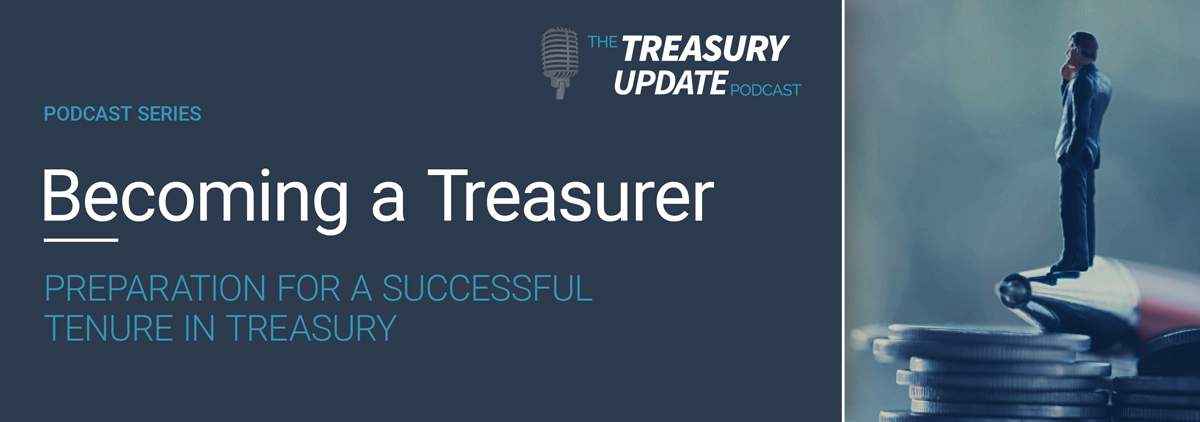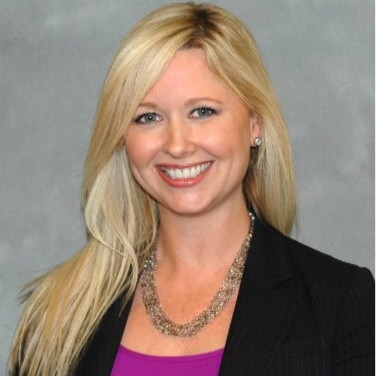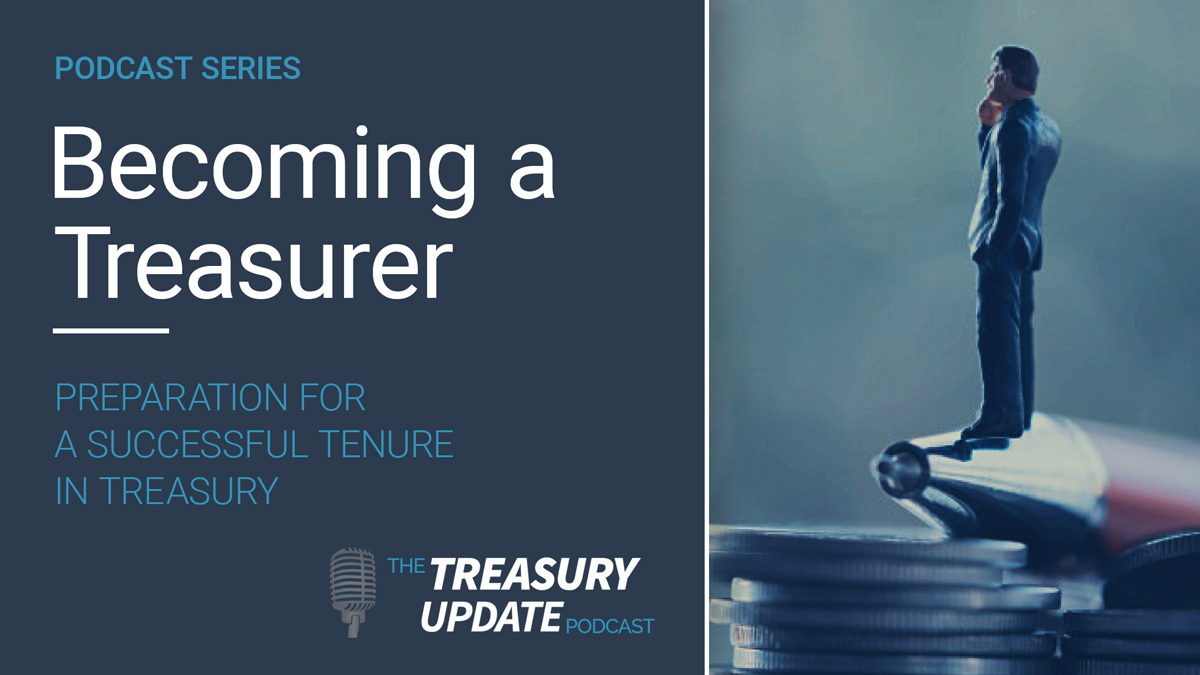
Episode 110
Becoming a Treasurer:
Part 11 – Learning from Literature:
Risk. Robert Frost
On this episode of the Becoming a Treasurer Series, Managing Partner Craig Jeffery of Strategic Treasurer kicks off a sub-series called “Learning From Literature”. He showcases Robert Frost’s poem The Door in the Dark as a metaphor to discuss the lessons of risks. Listen in as he shares how treasury professionals can increase visibility as disruptive events arise on their way to success.
Host:
Meredith Zonsius, Strategic Treasurer


Speaker:
Craig Jeffery, Strategic Treasurer


Episode Transcription - Episode 110 - Becoming a Treasurer Part-11
Meredith Zonsius:
Welcome to the Treasury Update Podcast presented by Strategic Treasurer, your source for interesting treasury news, analysis and insights in your car, at the gym or wherever you decide to tune in.
Meredith Zonsius:
On this episode of the Becoming A Treasurer series, Managing Director Craig Jeffery at Strategic Treasurer kicks off a subseries called Learning From Literature. He showcases Robert Frost’s poem The Door In The Dark as a metaphor to discuss the lessons of risks. Listen in as he shares how treasury professionals can increase visibility as disruptive events arise on their way to success.
Meredith Zonsius:
Welcome to the podcast, Craig.
Craig Jeffery:
Thanks Meredith. It’s good to be here again.
Meredith Zonsius:
Great. So, this is the 11th episode in the Becoming A Treasurer series. You have indicated that we will have several episodes in this series with a subheading called Learning From Literature. That probably requires an explanation to the question, “Why?” Is this a deviation from the practical approach of the series?
Craig Jeffery:
Maybe that’s a nice way of saying, “Have I gone soft?” because we’re talking about some literature. But it’s a little bit of a deviation, but it really will be tied back to what can we do to prepare to be a treasurer. Literature can give us a lot of ideas. Since literature writing, whether it’s poetry, stories, they can take us out of the normal business world, but look at similar type of issue or issues that have some relationship to what we face in treasury. That can help us with a better or more enriched view of what to do, how to proceed, how to think about things. That can help us prepare or respond to things.
Craig Jeffery:
I also thought it would be helpful to break up the series a bit, since we have focused on the practical approach and to some extent, moderate the technical aspect of it. But no, I haven’t gone soft, but wanted to branch out a little bit with some literature and get us thinking that way.
Meredith Zonsius:
Yeah, I love this direction. Risk is the subheading of today’s episode, the poet Robert Frost is listed. What poem is on tap for this?
Craig Jeffery:
His poem is In Going From Room To Room In The Dark. Many of you probably have heard of it, and if not, I think you’ll find it is one of his enjoyable poems. Maybe not as famous as some of the ones you may have memorized, but In Going From Room To Room In The Dark.
Meredith Zonsius:
Will you recite it for us?
Craig Jeffery:
I think I have to read it, I haven’t memorized it. I’ve not gone that soft yet, but yeah, his poem In Going From Room To Room In The Dark.
Craig Jeffery:
“In going from room to room in the dark, I reached out blindly to save my face, but neglected, however lightly, to lace my fingers and close my arms in an arc. A slim door got in past my guard and hit me a blow in the head so hard I had my native simile jarred. So people and things don’t pair anymore with what they used to pair with before,” by Robert Frost.
Craig Jeffery:
So that’s the poem.
Meredith Zonsius:
Perfect. Thank you for that. So I can see some connection with banging your head or not wanting to bang your head with risk of course. Could you talk me through the importance for risk management or risk in general?
Craig Jeffery:
You know, taking leave from Robert Frost’s poem about protecting your head or maybe even your toes in there. This poem really paints a scene and I think we can relate to it perhaps less so now than years ago. But you think about moving about in your house from room to room or in some location in the dark. It may be late, you don’t want to turn on the lights. Maybe there’s a power outage. Maybe a long time ago you didn’t even have power, but we understand that there are risks moving around in the dark.
Craig Jeffery:
The second part of that, in addition to moving around is, he’s trying to mitigate the risk by sticking his hands out to protect his head and face. And you can see that he has identified that there is a gap. He didn’t lace his fingers. And so there’s a gap between his hands sticking out in front of his face. And if you’ve extended your hands to show a space there too, you’re really imagining what’s going on. So this gap presents a situation where something gets past our guard and it’s the door. We didn’t hit it on an angle. It came in straight through the gap all the way to your forehead or face. We didn’t catch it directly. We weren’t walking at an angle so we didn’t pick it up when I had just gotten past the guard. But it got passed and we hit our head.
Craig Jeffery:
And so that’s the situation. There was a risk there. We thought we were mitigating it and we didn’t, and it knocked us.
Meredith Zonsius:
That’s a great explanation. How can this be linked to treasury? How do you take a lesson from Robert Frost on this?
Craig Jeffery:
Well, I think he’s obviously not talking about counterparty risk exposures or interest rate flexibility, or what’s going on with the markets, maybe the freezing up of the debt markets. But you know, this idea of darkness and the gap in our fingers are two things that are pretty interesting there.
Craig Jeffery:
So the darkness might be, we don’t have visibility to see our risk, to see our exposures, to see what’s going on. And the gap in our fingers can be the situation we’re not monitoring or scanning for all risks, or they come in away that we don’t expect.
Craig Jeffery:
And so one aspect is, we might not expect certain things in treasury. We don’t expect interest rates to being negative, right? How could that be? The floor would be zero and that’s happened. We may not expect Central Bank asset purchases to reach the level, either financial value or percentage of GDP of the Eurozone, of the US of, Australia, of the UK. We might not have expected this process where we have a reverse quarantine that shut down some businesses entirely where well people are kept from moving about. It’s something different that hadn’t been done in many, many, many… Well, from what we can tell ever. We might not have expected the freezing up of the debt markets, the money market markets in the way that they have at different times.
Craig Jeffery:
So certain things we don’t expect, we don’t anticipate them, whether you want to call them black swans or not. We don’t expect things or think that we can have a pretty big gap in our hands and we’re sure to catch something that big. But that gap in our fingers is not knowing what all the risks are, not scanning for them.
Craig Jeffery:
I imagine you’re the same way if you’re walking around in the dark, you don’t want to wake someone up. You shuffle slowly, you stick your hands out and perhaps you hit a door, perhaps you don’t. There might be a toy on the floor that you step on, or you stub your toe somewhere. There’s different levels of that banging that can take place.
Meredith Zonsius:
So the blow in the head seemed to be a big part of the poem.
Craig Jeffery:
Yeah. You can picture that. Whether it was a blow just to his head or his face, but it said, “It had my native simile jarred,” and his ability to make comparisons, right? He said, “People and things don’t pair anymore with what they used to pair with before.” I mean, that idea of this knocking your head, it rocked the framework he had. And I think it was a way of describing it changed how he was thinking of things mightily in a way, they didn’t pair. And that might be just from your head is jarred, so you’re not thinking there, but it also in treasury or the application I would like to make from that. And I’m sure those who love literature are saying, “You can’t do that with this poem.” But that idea of, if you bang your head in a way you don’t expect, you think about risks and exposures or certainly that exposure, that situation differently.
Craig Jeffery:
The phrase, “It’s not supposed to be this way.” Nobody could have anticipated this type of situation, but once you hit your head, you’re like, “Okay, I need to broaden my scan. I need to tighten my coverage, my interlace, my fingers, if you will. I don’t want to have a damaging or fatal incident.” If it’s not damaging or fatal, it could be a really good teacher for us. And I know I shared with you when you were hosting one of these podcasts, I talked about examples that might be embarrassing. I remember being responsible for overdrawing a bank. Let’s just say it was well north of a hundred million dollars. And there’s certain situations that went into doing that with certain transfers not occurring with a move to a new system. And I don’t say that as embarrassment, but to say a lot of recovery steps had to be taken that morning, not only to swallow my pride, but to talk to people to get things rectified as quickly as possible.
Craig Jeffery:
And I’ll tell you that was a learning incident that was multiple decades ago and I have not forgotten it. And it has influenced so much of what I do and advise in the areas of risk to make sure you’re thinking broadly about the risks. And so this idea of things can happen that are caused by your processes or systems or disruptive events can arise and we have to adapt. You can stand still if you think you can and not move, and therefore you’re not going to plow into a door or have it clock you in the head.
Craig Jeffery:
But oftentimes we need to make progress. Our business needs to continue. You need to keep moving. And so you can walk slowly, you can walk carefully. You can shuffle your feet, engage what’s going on. You can stick your hands out, you can move them back and forth, but we need to adapt and still have ways of understanding these things. If you can’t get the visible you want at that time. We want to have as much visibility as possible, but we want to have additional layers that protect us. So, the interlaced fingers, if you will. Scanning the environment for risks and exposures and having early warning signs, early warning indicators that tell us if we’re approaching something. The pull up on the airplane is the equivalent of your fingers bumping into the wall, the door jam, or the door.
Meredith Zonsius:
What questions to treasury professionals on their way to becoming a treasurer do we need to answer?
Craig Jeffery:
That’s a good question. That’s the realistic and application side of things. I’d say, “In what ways are we walking in the dark and how can we increase the visibility, increase the light that we have in those areas?” And that can be, I’m sure you’ve heard me talk about counterparty exposures, foreign currency exposures, commodity price exposures, trading partners, et cetera. So, understanding where we walk in the dark, or where we walk in where we don’t have enough light to see clearly. That would be one: how do we increase the visibility?
Craig Jeffery:
Number two: where are the gaps in our fingers that need to be closed? What level of pain is worth it? So in the poem, it was bumping our arms and you can also think about stubbing our toe or receiving a blow to our head. I would much rather hit something with my arms than my toe, and certainly than my head or my face. So what are those gaps? So it’s not just what’s dark, but what are those gaps for monitoring and managing it? Whether it’s avoiding certain risks, mitigating those through operations, using financial instruments to reduce those. So think about those gaps. And this is the discipline of risk management.
Craig Jeffery:
And then I think the third question is: what early warning indicators do we have in place, and what can we add? And this covers things like what systems can tell us we’re approaching a limit, just like your car when you’re backing up now, you can see an image of it or it gives you an indicator if you’re changing lanes or if you’re drifting. It gives you some extra help to note that you’re approaching danger. It doesn’t just say, You hit a wall.” It says, “You’re about to bump into a wall. Are you paying attention?”
Craig Jeffery:
So there’s systems. There’s thinking. Are we gathering together? Thinking through ideas? What matters? How do we adapt to it? And then there’s people. And I don’t mean send someone ahead to bump into the wall first, bump through the door first, but how are we training people to think about risks, to think about payment security, to look at what they need to do structurally to support the business and reduce opportunities for defects or errors? And then this idea of, “Are we scanning the environment regularly?” That’s not only reading periodicals, listening to podcast, paying attention to what’s going on, having dialogue about what’s going on in the environment, our company environment, our industry. What’s going on in that can have an impact? How do we identify that early? Do we need to make any adjustment? Is that a risk that we bear?
Craig Jeffery:
Those are some of the things that I think if Robert Frost were a treasury person, that’s what we would take away as an application from In Going From Room To Room In The Dark.
Meredith Zonsius:
These are great points Craig, are you going to be expanding on these in the future with the series?
Craig Jeffery:
Yeah. I know we’ve covered a few of them to some extent before, but there’s certainly some aspects that we need to spend a little bit more time on. So this idea of what early warning indicators do we have in place and what can we add? That certainly changes over time. There’s certainly some great things that companies are doing that makes sense that might not have been possible just a few years ago. So that’s probably the biggest one. I know we’ve talked about the visibility front and then that idea of the gap in the fingers. What needs to be closed? At what rate of speed are you willing to suffer banging your toe or getting a blow to the head? There’s a few things on that that we certainly could expand on.
OUTRO:
You’ve reached the end of another episode of The Treasury Update podcast. Be sure to follow Strategic Treasurer on LinkedIn. Just search for Strategic Treasurer.
OUTRO:
This podcast is provided for informational purposes only, and statements made by Strategic Treasurer LLC on this podcast are not intended as legal, business, consulting or tax advice. For more information visit and bookmark strategictreasurer.com.
Related Resources
#TreasuryFAQ – YouTube Playlist
Check out our YouTube playlist covering many frequently asked questions in treasury!
Becoming a Treasurer – A Treasury Update Podcast Series
This series within The Treasury Update Podcast explores questions around being a successful treasurer. Topics discussed include preparation, what needs to be measured, effective communication, development of a team, and acquirement of resources needed.



